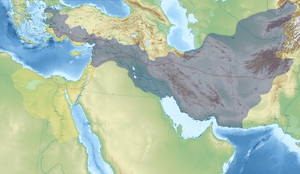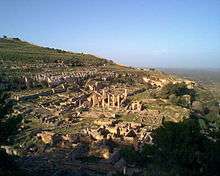Hegesias of Cyrene
Hegesias (Greek: Ἡγησίας; fl. 290 BC[1]) of Cyrene was a Cyrenaic philosopher. He argued that eudaimonia (happiness) is impossible to achieve, and that the goal of life should be the avoidance of pain and sorrow. Conventional values such as wealth, poverty, freedom, and slavery are all indifferent and produce no more pleasure than pain. Cicero claims that Hegesias wrote a book called ἀποκαρτερῶν (Death by Starvation), which persuaded so many people that death is more desirable than life that Hegesias was banned from teaching in Alexandria. It has been thought by some that Hegesias was influenced by Buddhist teachings.[2]
Life
Diogenes Laërtius describes Hegesias as the pupil of Paraebates, who was a pupil of Epitimedes, who was a pupil of Antipater of Cyrene, who was a pupil of Aristippus (c. 435 – c. 360 BC). He was the fellow-student of Anniceris, but he differed from Anniceris by presenting the system which Anniceris softened and improved in its most nihilistic form.[3]
Philosophy
Hegesias followed Aristippus in considering pleasure as the goal of life; but, the view which he took of human life was more pessimistic. Happiness, he said, could not be the goal of life, because it is not attainable, and therefore concluded that the wise person's only goal should be to become free from pain and sorrow. Since, too, every person is self-sufficient, all external goods were rejected as not being true sources of pleasure.
Complete happiness cannot possibly exist; for that the body is full of many sensations, and that the mind sympathizes with the body, and is troubled when that is troubled, and also that fortune prevents many things which we cherished in anticipation; so that for all these reasons, perfect happiness eludes our grasp. Moreover, that both life and death are desirable. They also say that there is nothing naturally pleasant or unpleasant, but that owing to want, or rarity, or satiety, some people are pleased and some vexed; and that wealth and poverty have no influence at all on pleasure, for that rich people are not affected by pleasure in a different manner from poor people. In the same way they say that slavery and freedom are things indifferent, if measured by the standard of pleasure, and nobility and baseness of birth, and glory and infamy. They add that, for the foolish person it is expedient to live, but to the wise person it is a matter of indifference; and that the wise person will do everything for his own sake; for that he will not consider any one else of equal importance with himself; and he will see that if he were to obtain ever such great advantages from any one else, they would not be equal to what he could himself bestow.[3]
Hence the sage ought to regard nothing but himself; action is quite indifferent; and if action, so also is life, which, therefore, is in no way more desirable than death.
The wise person would not be so much absorbed in the pursuit of what is good, as in the attempt to avoid what is bad, considering the chief good to be living free from all trouble and pain: and that this end was attained best by those who looked upon the efficient causes of pleasure as indifferent.[3]
None of this, however, is as strong as the testimony of Cicero,[4] who claims that Hegesias wrote a book called Death by Starvation (Greek: ἀποκαρτερῶν), in which a man who has resolved to starve himself is introduced as representing to his friends that death is actually more to be desired than life, and that the gloomy descriptions of human misery which this work contained were so overpowering that they inspired many people to kill themselves, in consequence of which the author received the surname of Death-persuader (Peisithanatos). This book was published at Alexandria, where he was, in consequence, forbidden to teach by king Ptolemy II Philadelphus (285-246 BC).
Indian connection


The philosophy of the Cyrenaics around the time of Hegesias of Cyrene evolved in a way that had similarities with Pyrrhonism, Epicureanism, and also Buddhism.[5]
The rulers of Cyrene around the time Hegesias flourished were Ophellas and then Magas, as governors of the Ptolemaic king of Egypt Ptolemy II Philadelphus, and from 276 BC Magas as independent king. Both Ptolemy and Magas are claimed to have been recipients of Buddhist missionaries from the Indian king Ashoka according to the latter's Edicts.[5][6][7] Ashoka claimed in his rock edicts No13:
Now it is conquest by Dhamma that Beloved-of-the-Gods considers to be the best conquest. And it (conquest by Dhamma) has been won here, on the borders, even six hundred yojanas away, where the Greek king Antiochos rules, beyond there where the four kings named Ptolemy, Antigonos, Magas and Alexander rule, likewise in the south among the Cholas, the Pandyas, and as far as Tamraparni. Here in the king's domain among the Greeks, the Kambojas, the Nabhakas, the Nabhapamktis, the Bhojas, the Pitinikas, the Andhras and the Palidas, everywhere people are following Beloved-of-the-Gods' instructions in Dhamma. Even where Beloved-of-the-Gods' envoys have not been, these people too, having heard of the practice of Dhamma and the ordinances and instructions in Dhamma given by Beloved-of-the-Gods, are following it and will continue to do so.
The philosophy of Hegesias displays striking similarities with the tenets of Buddhism,[5] in particular the Four Noble Truths and the concept of Dukkha or "suffering". It is therefore sometimes thought that Hegesias may have been directly influenced by Buddhist teachings through contacts with the alleged missionaries sent to his rulers in the 3rd century BC.[lower-alpha 1][2]
See also
- Existential nihilism
- Negative utilitarianism
- Philosophical pessimism
Notes
- "The philosopher Hegesias of Cyrene (nicknamed Peisithanatos, "The Death-Persuader") was contemporary of Magas and was probably influenced by the teachings of the Buddhist missionaries to Cyrene and Alexandria. His influence was such that he was ultimately prohited to teach" —Jean-Marie Lafont . Les Dossiers d'Archéologie (254): 78, INALCO .[9] Jean-Marie Guyau also paralleled his teachings to Buddhism.[10]
Citations
- Dorandi 1999, p. 47.
- Preus, Anthony (February 12, 2015). Historical Dictionary of Ancient Greek Philosophy. Rowman & Littlefield. ISBN 9781442246393 – via Google Books.
- Laërtius 1925, § 93–96
- Cicero, Tusculanae Quaestiones i. 34
- Clayman, Dee L. (February 15, 2014). Berenice II and the Golden Age of Ptolemaic Egypt. Oxford University Press. ISBN 9780195370898 – via Google Books.
- Allen, Charles (February 21, 2012). Ashoka: The Search for India's Lost Emperor. Little, Brown Book Group. ISBN 9781408703885 – via Google Books.
- Ruiter, Branko van Oppen de (February 3, 2016). Berenice II Euergetis: Essays in Early Hellenistic Queenship. Springer. ISBN 9781137494627 – via Google Books.
- The Edicts of King Ashoka: an English rendering by Ven. S. Dhammika. Access to Insight: Readings in Theravāda Buddhism. Last accessed 1 September 2011.
- Lafont, INALCO.
- "Encyclopédie sur la mort | Hégésias De Cyrène". Encyclopédie sur la mort.
References
- Dorandi, Tiziano (1999). "Chapter 2: Chronology". In Algra, Keimpe; et al. (eds.). The Cambridge History of Hellenistic Philosophy. Cambridge: Cambridge University Press. p. 47. ISBN 9780521250283.CS1 maint: ref=harv (link)

- Lafont, Jean-Marie. "INALCO". Les Dossiers d'Archéologie (254): 78.CS1 maint: ref=harv (link)
External links
- Cicero's Tusculum Disputations, which talks about Hegesias's Death by Starvation
- The Most Depressing Book Ever Written: Death by Starvation by Hegesias of Kyrene, with summary, background, and discussion of purpose
